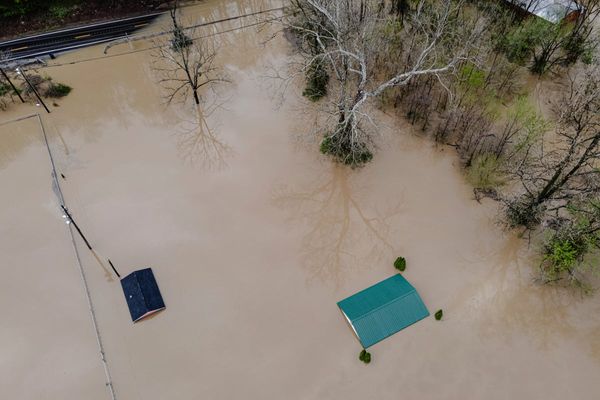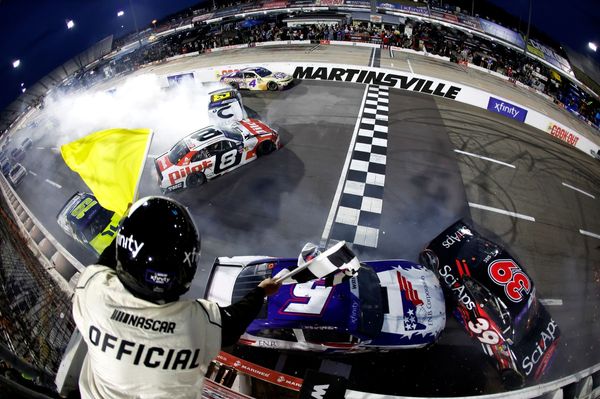
Anselm Kiefer is putting the finishing touches to his exhibition Finnegans Wake with the help of a forklift truck. The huge gallery at White Cube Bermondsey has been all but filled with a mound of shattered concrete surrounded by barbed wire, like a bombed second world war bunker. I watch as the wiry, bespectacled 78-year-old lion of German art directs the drop of a final piece of rubble into place, sending a rusty chunk of metal crashing on its side. “Perfect,” he says.
When we sit down to talk he tells me how he hacked out this broken mass from his studio. “There was a floor and I cut it from the sides and it fell down. And it was wonderful! Really great. And I had the idea, this is fantastic together with Finnegans Wake, because it’s the beginning of something, not the end. It’s the beginning. So I brought it here.”
The shattered floor is one of a series of installations and paintings that proliferate and interbreed in the addictive labyrinth that is Kiefer’s new London show. You come across golden snakes, bronze books, toy soldiers and a vitrine in which a heart is weighed against a feather (illustrating the ancient Egyptian belief in judgment after death – “If your heart is heavier than a feather you go to hell!”). All are brought together in celebration of James Joyce’s punning, mythic, dreamlike modern text Finnegans Wake. The title of the concrete mass is a quote from the book, that he’s scribbled across the gallery wall: “Phall if you but will, rise you must.” For Finnegans Wake sees history as a cycle of rise and fall, fall and rise, and that vision infuses this show.
The concrete wreckage looks tragic to me as grey dust rises from the rubble under dim lights, but Kiefer explains that he sees ruins as a beginning, not an end. It comes from being born in 1945 in the last apocalyptic months of the war, in Donaueschingen, a pretty town in the Black Forest.

“When I was born I was in the hospital with my mother in the cellar. And then this night our house was bombed. If they hadn’t been in the hospital they would be dead, me included. It’s interesting, no? And then as a child I had no Spielzeuge – no toys. So I built all these houses with the bricks from the ruin. I had all that I wanted. Because my family had moved into the house next to this bombed house. I was next to the ruins, it was fantastic. As a child you don’t judge. You take what it is and keep it. For me it was not a catastrophe. It was my toys.”
Kiefer’s childhood in a ruined country, next to his family’s ruined house, made him the artist he is: one who has excavated the bomb site of modern history. His paintings and installations encompass the nightmares of the past with relish. They are sublimely pungent, ripened monuments with a scope and seriousness that leaves most contemporary art looking flat and simplistic.
Yet his daunting works have sometimes been accused of the sins they criticise. Even though I’m familiar with his oeuvre I’m startled when he performs a Nazi salute for me. It’s an impromptu restaging of the controversial “Action”, as he terms it, with which as a young artist in 1969 he announced his intention to look Germany’s history straight in the eye. Kiefer stood to attention in romantic landscapes, by the sea or in front of classical temples, to be photographed giving the same straight-armed salute he does for me now. He doesn’t mean it now and didn’t then: his Fawltyesque performance was a mockery of the will to power. The first person who got it, he tells me, was the great performance artist and sculptor of felt and fat Joseph Beuys, who simply declared: “It’s a good action.”
When I ask if it was playing in bombed rubble that made him an artist, he says it wasn’t quite as raw as that. He grew up in a cultured, art-loving family. “I had an aunt who was a watercolourist and so the painters and artists were always present, in books, in what they told me: Klee, Kandinsky, Van Gogh. All these painters who were not appreciated in the Third Reich, but then after the war the Germans tried to make it better.”
Van Gogh’s shadow looms in his new show on an extravagant, stunning scale. His gigantic painting called – in another Joyce quote – Meednight Sunflower is a mesmerising vision of tall sunflowers with black petals. To me they are macabre, but Kiefer sees them as symbols of the cyclical nature of being: “First the sunflower is connected with the stars, because it moves its head against the sun. And in the night it’s closed. The moment they explode they are yellow and fantastic: that’s already the declining point. So sunflowers are a symbol for our condition d’etre.”
Another towering canvas portrays a host of shattered-seeming people under an exploding sky. Its matted layers of torn cloth saturated in thick paint have the coagulated coarseness of a living world where real shoes hang suspended in the stormy sky.

This is the kind of sublimity that Kiefer sceptics hold against him. Not everyone in the German or international art world agreed with his mission to make history urgent by recapturing an expressive Romantic grandeur worthy of Wagner. When he and his fellow “neo-expressionist” Georg Baselitz put their historical provocations in the German pavilion at the Venice Biennale in 1980, they were accused of feasting on Nazi imagery and creating a “Teutonic necropolis”, in the words of Artforum magazine.
You only have to listen to Kiefer talk about literature to realise how absurd that is and how far he is from being bombastic. He’s honest, and funny, about his lifelong efforts to understand Finnegans Wake, a novel whose story, if it can be called that, lies buried under layers of wordplay that make even the first sentence a monolith of a challenge: “riverrun, past Eve and Adam’s, from a swerve of shore to bend of bay, brings us by a commodius vicus of recirculation back to Howth Castle and Environs.”
Kiefer admits the book has been practically a life’s work to get through: “I started it long ago and I gave up. And then I restarted with English on the left and German on the right side, and then I thought this is completely crazy. And then I started again and again, and in the meantime I had discs, you know? By an actor – and this was wonderful. I had it in my studio all the time. It’s like music.”
He has come to love this book and see it as a mirror of his own life and art. Two spaces of his show are crammed with objects that recreate just a small part of what he calls his “arsenal”, a huge store where he keeps works from decades of obsessive collecting and making: “It’s a kilometre long. All this stuff, it’s like my head, you know. Some was finished, some was not finished, and I thought: ‘It’s like going through the Finnegans Wake book!’”The show is like a parallel text: Kiefer’s art and Joyce’s words side by side. A whole room is hung with gorgeous paintings of gold and matted green like psychedelic Monets. One is named Liffey; others too are titled after watery images from Finnegans Wake.

The flow of Kiefer’s art is like a river, but its darkness lies in the vision of time as cyclical that he shares with Joyce. Finnegans Wake’s “vicus of recirculation” in its first sentence refers to the philosopher Giambattista Vico’s belief that humanity ascends through stages but then falls back, recirculates. Does he think the war in Ukraine means we can fall back into the nightmares of 20th-century Europe?
Putin’s war, he says, is “against all human law and international law. But you know, I think the west made a mistake in 1991. There was, I remember, a feeling of victory. The atmosphere was ‘we are the winner’ - and with atomic bombs, you are never the winner.”
I say that Germany and Britain may have different views because of our different experiences in the second world war. He expands more on the history of the 20th century: “At the end of the second world war there was triumph and it was good, it was necessary. And the sacrifice that English people made for that war. But ’91 it was not the time for triumph; ’45 yes because if Churchill wouldn’t have been there, perhaps Hitler would have made something with England because he liked the English people. Churchill was a great thinker.”
Kiefer even finds the modern history hidden in Joyce’s apparently apolitical text. One of the quotes he’s scribbled up shows the great writer had an ear for what was happening in Germany: it includes the word “Gestapose”, a pun on Gestapo.
Joyce is not Kiefer’s only literary hero. This London exhibition follows on from a recent show in Paris that paid homage to another of Kiefer’s affinities, Paul Celan. Born to a Jewish family in Czernowitz, then in Romania, now Ukraine, Celan survived the Holocaust in which his parents both died and became one of the greatest postwar poets in German, until his suicide in Paris in 1970. His poem Death Fugue has long haunted Kiefer’s works. “Joyce wrote in his own language but Celan wrote in the language of his murderers,” he says.
Books, as the image of our fragile human collective conscience, are everywhere in Kiefer’s art. There are burned books and books with wings to fly. In this latest exhibition, the entire gallery becomes a manifestation of a single book. I find a heap of books, cast in bronze, crawling with snakes. A nightmare image that evokes Celan as well as Joyce. “History is a nightmare from which I am trying to awake,” says Joyce’s character Stephen Dedalus. I quote this to Anselm Kiefer.
“Sure. It’s full of nightmares,” he says. “It’s still a nightmare.”
Anselm Kiefer: Finnegans Wake is at White Cube Bermondsey, London until 20 August







